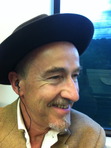In Dubious Battle, a beckoning beacon
‘At last it was evening. The lights on the street outside came on, and the Neon restaurant sign on the corner jerked on and off, exploding its hard red light in the air. Into Jim Nolan’s room the sign threw a soft red light. For two hours Jim had been sitting in a small, hard rocking-chair, his feet up on the white bedspread. Now that it was quite dark, he brought his feet down to the floor and slapped the sleeping legs. For a moment he sat quietly while waves of itching rolled up and down his calves; then he stood up and reached for the unshaded light. The furnished room lighted up – the big white bed with its chalk white spread, the golden-oak bureau, the clean red carpet worn through to a brown warp.” In Dubious Battle…by John Steinbeck.
This was the book that gave me a start in writing. It was first book that taught me how to be a nighthawk with the other nighthawks in Edward Hopper‘s famous painting, where I could smell the coffee, the grease and the frying onions or, like Jim Nolan in the opening paragraph of John Steinbeck‘s 1936 novel, In Dubious Battle, sit in the clean, but faded, squalor of a boarding house bedroom in the flickering glare of a street front, neon sign.

Steinbeck’s book was written in 1936, in the middle of the Great Depression, and deals with how people, under pressure, work together. It is set against the background of the Californian fruit pickers’ strikes of the ’30s, of which there were 43 in all. It follows the progress of Jim Nolan, from a well read, out of work labourer to Communist Party recruit and then to committed activist, against the backdrop of a fruit pickers’ strike against exploitative and well organized growers’ associations.
Steinbeck often spoke of it as his favourite novel but check out the many online biographies of the Pulitzer and Nobel prize winning author and you’ll see hardly a scant mention of it. Ironically, US President Barack Obama has often credited it as his favourite American novel. Now James Franco, acclaimed American actor and activist, has made a film of Steinbeck’s book, unveiled this weekend at the Venice Film Festival.
Steinbeck’s realistic writing style was perfect for its time but it has endured, too. If Hemingway stripped writing to its bare essentials, Steinbeck, I believe, took that sparse framework and added colour. There was nothing wasted but his deft touch added shade, depth and dimension to his characters, place and context.
The copy I have of In Dubious Battle was bought by my father in 1967 and quickly annexed by me. It cost five shillings then, the equivalent of 25c today. That first paragraph dragged me in and from then on, I was gripped and like Jim Nolan, anxious to learn. By page 10 of the paperback, Jim lists off the writers he’d studied from the local library, in his efforts to educate himself. They include Plato, Bellamy, Herodotus, Carlyle, Spinoza, Hegel, Kant, Nietsche, Schopenhauer and Marx. Soon, I was in the local library looking for the same authors but realizing, very quickly, they were beyond by eager, precocious but inadequate 11 year old ambitions.
They stayed in my mind and I soon found other writers, contemporaries of Steinbeck who wrote with similiar sympathies and observational abilities. They included Dashiell Hammett, Upton Sinclair, Sinclair Lewis, Damon Runyon and Raymond Chandler.
In Dubious Battle is a book about class struggle, workers’ rights, economic repression and capitalist exploitation. It’s also a wonderful book about hard times and the indomitable human spirit and willingness to help and support one another.

This is an ideal time for the release of such a film and I hope James Franco has done it justice. The film has a sterling cast with , , , , and , among others.
If they’ve got it right, then it might help to refocus political priorities for American voters in the year of a contentious presidential election, an election where one of the single greatest irony is the positioning of an arch capitalist as the champion of blue collar workers and a likely future president of the United States.
We all have favourite books and I’ve often struggled with the notion of compiling a top ten list because I’d wonder who could I leave out? That list would certainly include Brian O’Nolan, James Lee Burke, Charles Dickens, John McGahern, William Trevor, Sebastian Barry, Raymond Chandler, Dashiell Hammett and Orhan Pamuk. But top of that list, without question, will be John Steinbeck and In Dubious Battle.
Postcard from a Pigeon
- Dermott Hayes's profile
- 4 followers





